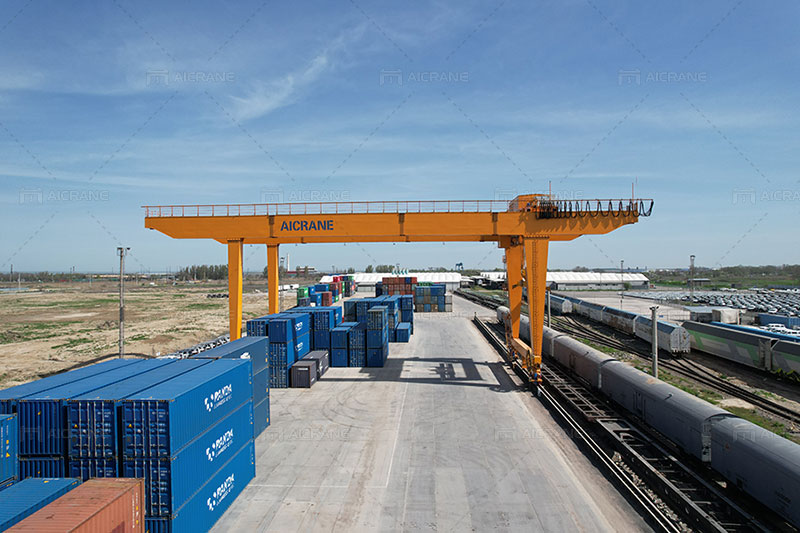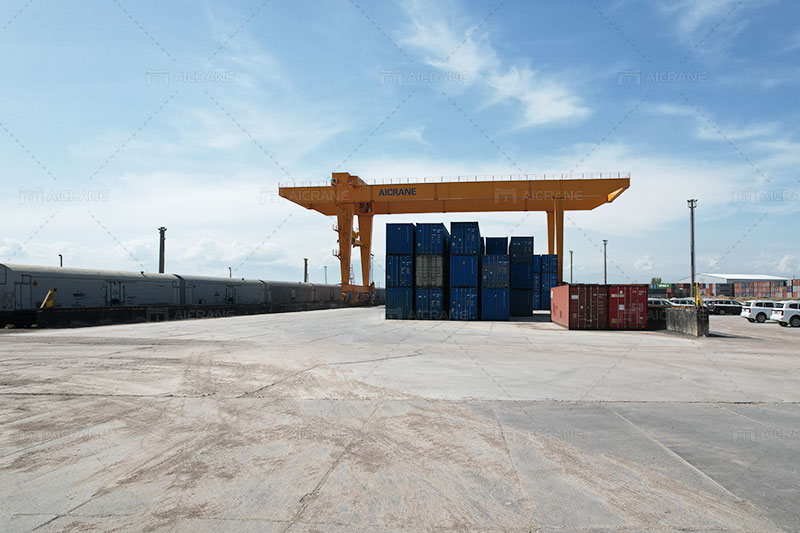Rail Mounted Gantry (RMG) cranes are widely used in container handling operations, intermodal yards, and industrial sectors requiring heavy lifting. They are known for their reliability, high efficiency, and ability to handle large volumes of goods. As essential equipment for container handling, RMG cranes provide precision, stability, and safety in their operations. This article explores how RMG cranes are controlled and the types of power supplies that these cranes utilize.

How RMG Cranes Are Controlled
1. Remote Control System
One of the most common methods of controlling rail mounted gantry cranes is through remote control systems. These systems allow the crane operator to manage the crane’s movements from a distance, using a portable control device. The remote control system provides flexibility, allowing the operator to move around the worksite and maintain a clear line of sight, especially when operating in areas with complex layouts or restricted visibility.
In many modern RMG cranes, the remote control is equipped with ergonomic features that reduce operator fatigue and increase precision. Key advantages of remote control systems include:
- Safety: By allowing operators to control the crane from a safe distance, the risk of injury is minimized, especially when handling hazardous or bulky loads.
- Operational Efficiency: Remote control provides operators with better visibility and situational awareness, leading to more accurate positioning of loads.
- Reduced Downtime: Remote operation often allows faster response times in situations requiring precise control, reducing downtime during operations.
2. Cabin Control
Another common control method for Aicrane container gantry cranes is via an operator’s cabin, typically mounted on the crane itself. The cabin is located at a height where the operator has a clear view of the operational area. From the cabin, the operator can directly control all the crane’s movements, such as lifting, lowering, and moving the load along the crane’s rails.
Cabin-controlled RMG cranes are often favored in environments where manual precision is crucial, and direct oversight of the load is necessary. Operators in the cabin use joysticks and control panels to manage the crane’s movements, making fine adjustments as needed. Benefits of cabin control include:
- Direct Control: The operator has immediate access to the crane’s full range of controls and can make real-time adjustments based on their view of the load.
- High Precision: Operators can directly monitor the positioning of the load, ensuring greater accuracy in delicate or complex maneuvers.
- Enhanced Productivity: Operators have constant visual contact with the load, leading to quicker and more efficient material handling.

3. Automated Control Systems
As industries increasingly shift towards automation, many modern RMG cranes are equipped with fully automated control systems. These systems reduce the need for manual operation by using computer algorithms to control crane functions. Automated RMG cranes can perform tasks such as load positioning, stacking, and transportation without direct human intervention.
Automation in RMG crane control is especially popular in large container yards and intermodal terminals, where efficiency, consistency, and high throughput are critical. The electric gantry crane operates based on pre-programmed instructions, and sophisticated sensors and cameras ensure that loads are moved precisely. Advantages of automated control systems include:
- Increased Efficiency: Automated RMG cranes can work continuously without fatigue, increasing operational throughput and reducing human error.
- Consistency: Automated systems perform repetitive tasks with high consistency, ensuring that container stacking and movement are done with minimal deviation.
- Cost Savings: While the initial investment in automation is high, long-term savings are realized through reduced labor costs and higher efficiency.
4. Semi-Automated Control Systems
Semi-automated RMG cranes combine the benefits of automation with manual oversight. In these systems, certain crane functions, such as movement along the rails or basic load lifting, are automated, while more complex maneuvers are controlled by an operator. This hybrid approach allows for increased efficiency while maintaining human control for precision tasks.
Semi-automated RMG cranes are popular in environments that require a high degree of flexibility. Operators can take over control during specific stages of a task, such as fine-tuning load positioning, while the system handles more routine operations.
5. Supervisory Control and Data Acquisition (SCADA)
Many modern RMG cranes integrate with Supervisory Control and Data Acquisition (SCADA) systems. SCADA systems provide centralized control, monitoring, and data collection across multiple cranes and other lifting equipment. Operators can oversee the entire terminal or yard’s operations from a central location, optimizing workflow and identifying potential issues in real time.
SCADA systems allow operators to monitor crane performance, receive alerts on maintenance needs, and track efficiency metrics. The integration of SCADA with RMG cranes leads to:
- Improved Operational Coordination: Multiple cranes and pieces of equipment can be monitored and controlled from a central location, improving efficiency across the entire facility.
- Enhanced Safety Monitoring: SCADA systems can automatically detect unsafe conditions and halt operations, reducing the risk of accidents.
- Real-Time Data Collection: Performance data is collected in real time, allowing operators to make data-driven decisions to optimize crane utilization.
Types of Power Supply for RMG Cranes
RMG cranes require a reliable and consistent power supply to operate efficiently. These cranes are usually powered by electricity, though the specific power supply methods may vary depending on the application and the operational environment.
1. Electrical Grid Power
Most RMG cranes are powered by an electrical grid, with the crane connected directly to a high-voltage power source. This is typically achieved through cable reels or conductor bars (also known as busbars), which supply electricity to the crane as it moves along its tracks.
- Cable Reels: Cable reels provide a flexible method of supplying power to the crane. The cables are wound onto a reel that moves with the crane, unwinding and rewinding as necessary to maintain a continuous power supply. This system is especially useful for cranes operating over long distances.
- Conductor Bars: Conductor bars are mounted along the crane’s rails, providing a continuous electrical connection. As the crane moves, a sliding contact transfers power from the conductor bars to the crane. Conductor bars are preferred for their durability and ability to supply uninterrupted power without the need for cables.
2. Backup Power Systems
Many RMG cranes are equipped with backup power systems, such as uninterruptible power supplies (UPS) or diesel generators. These systems ensure that the crane remains operational even during power outages, preventing costly downtime in critical operations. Backup power systems may also be used to safely lower loads and park the crane if the primary power supply fails.
3. Energy-Efficient Power Systems
In recent years, energy efficiency has become a key focus in the design of RMG cranes. Many cranes now incorporate regenerative power systems that capture energy generated during load lowering or deceleration and store it for later use. This reduces overall power consumption and contributes to more sustainable operations.
Energy-efficient RMG cranes often use:
- Regenerative Drives: These systems capture the kinetic energy generated during braking or lowering and convert it into electrical energy, which is then fed back into the crane’s power system or the grid.
- Hybrid Power Systems: Some RMG cranes combine electrical grid power with energy storage systems, such as batteries, to reduce peak power demands and improve energy efficiency.
Conclusion
RMG cranes play a critical role in container handling and other industrial applications, and their control systems are continually evolving. From remote control and cabin-operated systems to fully automated cranes, each control method offers specific advantages in terms of safety, precision, and efficiency. Additionally, RMG cranes are primarily powered by electricity, with options for backup and energy-efficient systems ensuring uninterrupted and sustainable operations.
As technology advances, the integration of automated and semi-automated systems, along with energy-saving technologies, will continue to shape the future of RMG crane operations, making them more reliable and environmentally friendly for various industries.